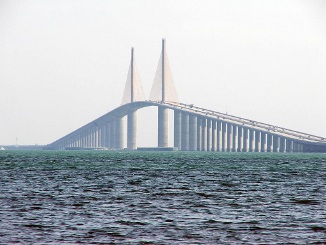 We have the longest fishing pier in the state with the old Sunshine Skyway Bridge that’s now been turned into a fishing pier across Tampa Bay. The Skyway Bridge stretches from Manatee County to Pinellas County and you can fish either the north or south span. The Skyway Pier produces everything from mangrove snapper to king mackerel, cobia, tarpon, grouper and sharks. It’s really a remarkable place to fish from shore.
We have the longest fishing pier in the state with the old Sunshine Skyway Bridge that’s now been turned into a fishing pier across Tampa Bay. The Skyway Bridge stretches from Manatee County to Pinellas County and you can fish either the north or south span. The Skyway Pier produces everything from mangrove snapper to king mackerel, cobia, tarpon, grouper and sharks. It’s really a remarkable place to fish from shore.
There’s a tackle shop and snack bar at the base of the Skyway Pier where you can pick up bait and some local fishing information. It really doesn’t matter what your skill level is, there’s something everyone can target and catch from that pier.
There’s also two fishing piers on Anna Maria Island that sticks out into the Gulf of Mexico. The Venice Pier is also a beach pier that extends into the Gulf. At these piers, you can catch snook, snapper, whiting and sheepshead, and when they’re running, pompano, cobia and king or Spanish mackerel. Some guys even float big baits out on an easterly wind for the big kings that run the beaches chasing the bait schools.
At any of these piers you want to gear your tackle to the fish you’re trying to target, and keep in mind that you’re going to have to deal with the hooked fish wanting to swim into the pilings and break you off, so you want to use gear that’s heavy enough to control the fish when they get close to the pilings. The majority of guys fishing the piers are targeting snapper, sheepshead, whiting, croaker and flounder—food fish that rarely exceed 10 pounds, so they gear up with 20 pound tackle.
Live shrimp are one of the best baits to use around the piers, and you can fish them on the standard fish finder rig that bounces the bottom, or just put them on a 3/8 to ½ ounce jighead and bounce it near the pilings. For those species, you can get away with a 30 pound monofilament leader.
For the larger fish like grouper, tarpon, snook and cobia, 30 to 50 pound braided line is the way to go, either on conventional or spinning rods and reels. Depending on how far you want to cast, your rod should be anywhere from 7 to 10 feet in length, the longer the rod the longer the cast. You can also bring a light 15 to 20-pound rod along rigged with a Sabiki rig to catch threadfins, sardines and pilchards for bait.
Once you have the bait, if you’re after snook and tarpon, the best fishing will be around the pilings, usually out near the end of the beach piers, but anywhere on the Skyway Pier. Just look for the bait schools—a lot of the snook and tarpon like to hang around the bait looking for injured fish to feed on. If you plan to freeline the live baits, you can hook them in the back or throat to get them to swim down below the school where they’ll be easy for the snook and tarpon to find. You can also add a 1 to 2 ounce twist on sinker about 36 inches above the hook to get the bait down. I like to fish 5/0 to 7/0 circle hooks on 60 pound monofilament leader around the pilings for snook and tarpon.
If kingfish or sharks are your target, the best thing to do is float a bait out from the pier on a balloon or large float rig. You need an east wind (offshore) to do that so it will carry the baits out to sea. Live blue runners, small jacks and ladyfish are probably the best baits, and you can use the same 30 to 50 pound gear you use for snook and tarpon, although conventional tackle is probably better than spinning tackle because it holds a lot more line. Rig up with about two feet of #4 wire for the kingfish and six feet of #8 wire for the sharks. I like a two hook stinger rig made with #4 treble hooks for kings, and a 9/0 circle hook for sharks.
One thing you want to consider before you even step onto any of the piers or bridges in my area, and that’s what you’re going to do when you get a fish to the surface and want to land it. Lifting the fish up from the water with the rod isn’t a good option, as a lot of fish will pull free from the hook and fall back into the water. It’s best to bring along a hoop net on a long line that you can lower down to the water and then maneuver the fish into and then use the heavier line to pull it up to the top of the pier. Hoop nets aren’t very expensive, and will allow you to land fish and measure them and then release them if they’re too big or small.
Think ahead before you head to the piers and plan out exactly what fish you want to target, what you plan to do for bait and what you’ll do if you get something big in, and you’ll be prepared for anything that can come your way. It’s better to be ready for anything than to not have a shot at fish, bait or landing a great catch!

